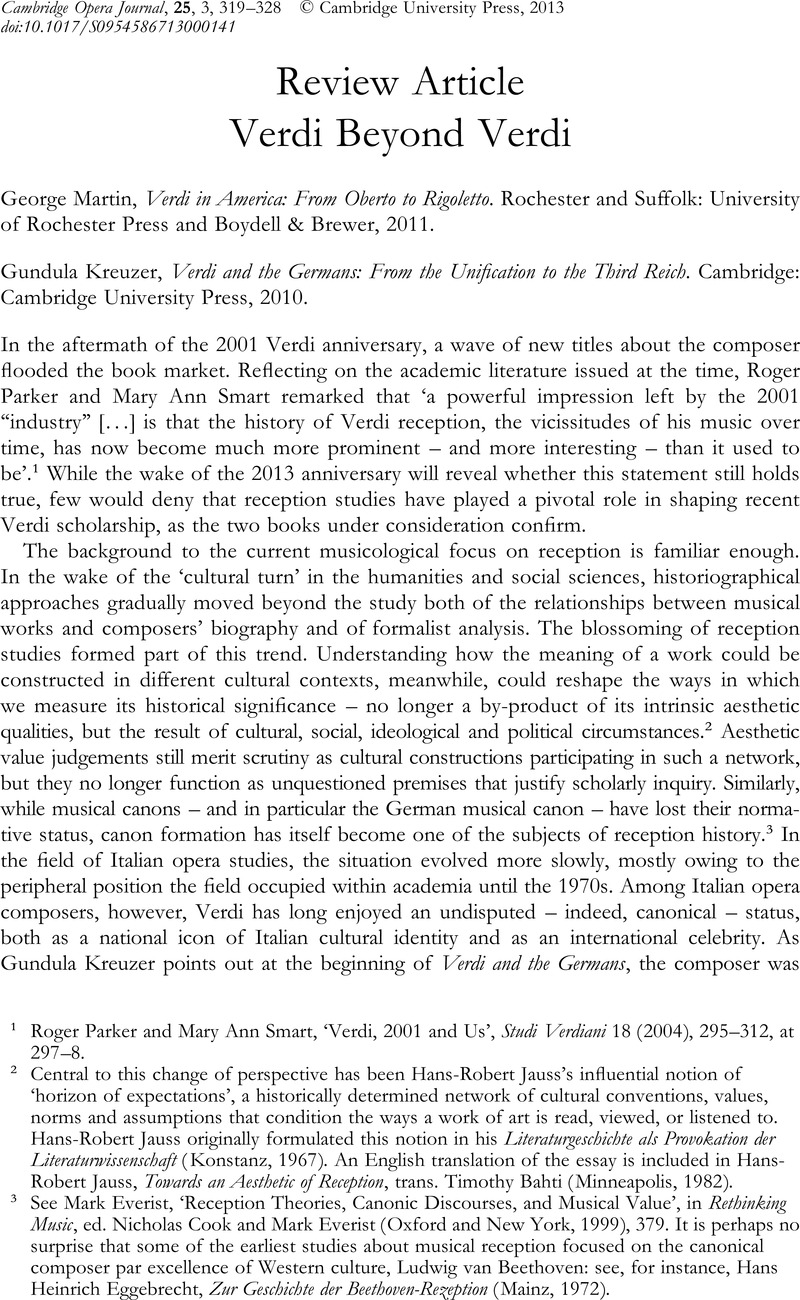No CrossRef data available.
Article contents
Verdi Beyond Verdi
Published online by Cambridge University Press: 05 November 2013
Abstract

- Type
- Review Article
- Information
- Copyright
- Copyright © Cambridge University Press 2013
References
1 Parker, Roger and Smart, Mary Ann, ‘Verdi, 2001 and Us’, Studi Verdiani 18 (2004), 295–312, at 297–8Google Scholar.
2 Central to this change of perspective has been Hans-Robert Jauss's influential notion of ‘horizon of expectations’, a historically determined network of cultural conventions, values, norms and assumptions that condition the ways a work of art is read, viewed, or listened to. Jauss, Hans-Robert originally formulated this notion in his Literaturgeschichte als Provokation der Literaturwissenschaft (Konstanz, 1967)Google Scholar. An English translation of the essay is included in Jauss, Hans-Robert, Towards an Aesthetic of Reception, trans. Bahti, Timothy (Minneapolis, 1982)Google Scholar.
3 See Everist, Mark, ‘Reception Theories, Canonic Discourses, and Musical Value’, in Rethinking Music, ed. Cook, Nicholas and Everist, Mark (Oxford and New York, 1999), 379Google Scholar. It is perhaps no surprise that some of the earliest studies about musical reception focused on the canonical composer par excellence of Western culture, Ludwig van Beethoven: see, for instance, Eggebrecht, Hans Heinrich, Zur Geschichte der Beethoven-Rezeption (Mainz, 1972)Google Scholar.
4 For two different approaches to this matter, see Parker, Roger, ‘Arpa d'or dei fatidici vati’: The Verdian Patriotic Chorus in the 1840s (Parma, 1997)Google Scholar, and Gossett, Philip, ‘“Edizioni distrutte” and the Significance of Operatic Choruses during the Risorgimento’, in Opera and Society in Italy and France from Monteverdi to Bourdieu, ed. Johnson, Victoria, Fulcher, Jane F. and Ertman, Thomas (Cambridge, 2007), 181–242CrossRefGoogle Scholar. Surveys of recent scholarly literature on this issue are provided by Francesca Vella's review article ‘A Passion for Italy’, this journal 23/3 (2012), 191–200; and by Smart, Mary Ann, ‘Magical Thinking: Reason and Emotion in Some Recent Literature on Verdi and Politics’, Journal of Modern Italian Sutdies 17/4 (2012), 437–47CrossRefGoogle Scholar.
5 For a recent discussion of these issues, albeit in a later period, see Davide Ceriani, ‘Italianizing the Metropolitan Opera House: Giulio Gatti-Casazza's Era and the Politics of Opera in New York, 1908–1935’ (Harvard University, 2011).
6 On the cultural conditions from which ‘conceptual’ operatic productions emerged, see Levin, David, Unsettling Opera: Staging Mozart, Verdi, Wagner, and Zemlinksy (Chicago and London, 2007), 18–30CrossRefGoogle Scholar.
7 See the last chapter of Kiesewetter, Raphael, Geschichte der europäisch-abenländischen oder unsrer heutigen Musik (Leipzig, 1834), 97–100Google Scholar.
8 In 1843 Verdi conducted the Viennese premiere of Nabucco at the Kärntnertortheater upon invitation of the impresario Bartolomeo Merelli. Merelli, who at the time was the manager of both La Scala in Milan and of the Kärntnertortheater, had commissioned the opera to Verdi the previous year. See Springer, Christian, ‘Verdi in Wien’, in his Verdi-Studien (Vienna, 2005), 15–24Google Scholar.
9 As this review was going to press, the publication of a new volume containing fourteen case studies on Verdi reception was announced: Frassà, Lorenzo and Niccolai, Michela, eds., Verdi Reception (Turnhout: Brepols, 2013)Google Scholar.




